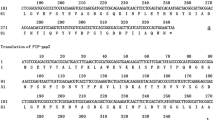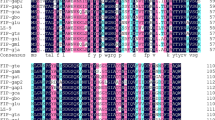Abstract
Fungal immunomodulatory protein (FIP)-sch2, an immunomodulatory protein identified in the ascomycete Stachybotrys chlorohalonata by a sequence similarity search, is a novel member of the FIP family. FIP-sch2 shares high sequence identity, structure, and evolutionary conservation with previously reported FIPs. It was satisfactorily expressed in Escherichia coli with a glutathione S-transferase (GST) tag and purified by GST-affinity magnetic beads. To characterize the direct antitumor effects, human lung adenocarcinoma A549 cells were treated with different concentrations of recombinant FIP (rFIP)-sch2 in vitro, and the results showed that rFIP-sch2 could reduce cell viability dose-dependently with a half-maximal inhibitory concentration (IC50) of 9.48 μg/mL. Furthermore, rFIP-sch2 at 8 μg/mL could significantly induce apoptosis and interrupt migration in A549 cells. Notably, the antitumor effect of rFIP-sch2 was equivalent to that of rLZ-8 but was obviously increased compared to rFIP-fve. In addition, the exploration of the antitumor mechanism suggested that rFIP-sch2 induced lung cancer cell death by activating apoptosis and inhibiting migration. Our results indicated that rFIP-sch2 was a promising candidate for use in future cancer therapy.






Similar content being viewed by others
References
Asada M, Ebihara S, Numachi Y, Okazaki T, Yamanda S, Ikeda K, Yasuda H, Sora I, Arai H (2008) Reduced tumor growth in a mouse model of schizophrenia, lacking the dopamine transporter. Int J Cancer 123(3):511–518. doi:10.1002/ijc.23562
Bastiaan-Net S, Chanput W, Hertz A, Zwittink RD, Mes JJ, Wichers HJ (2013) Biochemical and functional characterization of recombinant fungal immunomodulatory proteins (rFIPs). Int Immunopharmacol 15(1):167–175. doi:10.1016/j.intimp.2012.11.003
Bizzozero L, Cazzato D, Cervia D, Assi E, Simbari F, Pagni F, De Palma C, Monno A, Verdelli C, Querini PR, Russo V, Clementi E, Perrotta C (2014) Acid sphingomyelinase determines melanoma progression and metastatic behaviour via the microphtalmia-associated transcription factor signalling pathway. Cell Death Differ 21(4):507–520. doi:10.1038/cdd.2013.173
Borcherding DC, Tong W, Hugo ER, Barnard DF, Fox S, LaSance K, Shaughnessy E, Ben-Jonathan N (2016) Expression and therapeutic targeting of dopamine receptor-1 (D1R) in breast cancer. Oncogene 35(24):3103–3113. doi:10.1038/onc.2015.369
Carpinteiro A, Dumitru C, Schenck M, Gulbins E (2008) Ceramide-induced cell death in malignant cells. Cancer Lett 264(1):1–10. doi:10.1016/j.canlet.2008.02.020
Chang HH, Yeh CH, Sheu F (2009) A novel immunomodulatory protein from Poria cocos induces toll-like receptor 4-dependent activation within mouse peritoneal macrophages. J Agric Food Chem 57(14):6129–6139. doi:10.1021/jf9011399
Chang YC, Hsiao YM, Wu MF, Ou CC, Lin YW, Lue KH, Ko JL (2013) Interruption of lung cancer cell migration and proliferation by fungal immunomodulatory protein FIP-fve from Flammulina velutipes. J Agric Food Chem 61(49):12044–12052. doi:10.1021/jf4030272
Chiu LY, Hu ME, Yang TY, Hsin IL, Ko JL, Tsai KJ, Sheu GT (2015) Immunomodulatory protein from Ganoderma microsporum induces pro-death autophagy through Akt-mTOR-p70S6K pathway inhibition in multidrug resistant lung cancer cells. PLoS One 10(5):e0125774. doi:10.1371/journal.pone.0125774
Cong WR, Xu H, Liu Y, Li QZ, Li W, Zhou XW (2014) Production and functional characterization of a novel fungal immunomodulatory protein FIP-SN15 shuffled from two genes of Ganoderma species. Appl Microbiol Biotechnol 98(13):5967–5975. doi:10.1007/s00253-014-5539-4
Cotter TG (2009) Apoptosis and cancer: the genesis of a research field. Nat Rev Cancer 9(7):501–507. doi:10.1038/nrc2663
Ding Y, Seow SV, Huang CH, Liew LM, Lim YC, Kuo IC, Chua KY (2009) Coadministration of the fungal immunomodulatory protein FIP-fve and a tumour-associated antigen enhanced antitumour immunity. Immunology 128(1 Suppl):e881–e894. doi:10.1111/j.1365-2567.2009.03099.x
Felsenstein J (1985) Confidence limits on phylogenies: an approach using the bootstrap. Evolution 39(4):783–791
Hsin IL, Ou CC, Wu TC, Jan MS, Wu MF, Chiu LY, Lue KH, Ko JL (2011) GMI, an immunomodulatory protein from Ganoderma microsporum, induces autophagy in non-small cell lung cancer cells. Autophagy 7(8):873–882
Hsu HC, Hsu CI, Lin RH, Kao CL, Lin JY (1997) Fip-vvo, a new fungal immunomodulatory protein isolated from Volvariella volvacea. Biochem J 323(Pt 2):557–565
Huang L, Sun F, Liang C, He YX, Bao R, Liu L, Zhou CZ (2008) Crystal structure of LZ-8 from the medicinal fungus Ganoderma lucidum. Proteins 75(2):524–527. doi:10.1002/prot.22346
Ivanova H, Vervliet T, Missiaen L, Parys JB, De Smedt H, Bultynck G (2014) Inositol 1,4,5-trisphosphate receptor-isoform diversity in cell death and survival. Biochim Biophys Acta 1843(10):2164–2183. doi:10.1016/j.bbamcr.2014.03.007
Jarvis WD, Grant S, Kolesnick RN (1996) Ceramide and the induction of apoptosis. Clin Cancer Res 2:1–6
Kim YH, Girard L, Giacomini CP, Wang P, Hernandez-Boussard T, Tibshirani R, Minna JD, Pollack JR (2006) Combined microarray analysis of small cell lung cancer reveals altered apoptotic balance and distinct expression signatures of MYC family gene amplification. Oncogene 25(1):130–138. doi:10.1038/sj.onc.1208997
Kino K, Yamashita A, Yamaoka K, Watanabe J, Tanaka S, Ko K, Shimizu K, Tsunoo H (1989) Isolation and characterization of a new immunomodulatory protein, Ling Zhi-8 (LZ-8) from Ganoderma lucidum. J Biol Chem 264(1):472–478
Ko JL, Hsu CI, Lin RH, Kao CL, Lin JY (1995) A new fungal immunomodulatory protein, FIP-fve isolated from the edible mushroom, Flammulina velutipes and its complete amino acid sequence. Eur J Biochem 228(2):244–249
Li F, Wen H, Liu X, Zhou F, Chen G (2012) Gene cloning and recombinant expression of a novel fungal immunomodulatory protein from Trametes versicolor. Protein Expr Purif 82(2):339–344. doi:10.1016/j.pep.2012.01.015
Li QZ, Wang XF, Zhou XW (2011) Recent status and prospects of the fungal immunomodulatory protein family. Crit Rev Biotechnol 31(4):365–375. doi:10.3109/07388551.2010.543967
Li SY, Nie Y, Ding Y, Shi LJ, Tang XM (2014) Recombinant expression of a novel fungal immunomodulatory protein with human tumor cell antiproliferative activity from Nectria haematococca. Int J Mol Sci 15(10):17751–17764. doi:10.3390/ijms151017751
Li SY, Shi LJ, Ding Y, Nie Y, Tang XM (2015) Identification and functional characterization of a novel fungal immunomodulatory protein from Postia placenta. Food Chem Toxicol 78:64–70. doi:10.1016/j.fct.2015.01.013
Liao CH, Hsiao YM, Lin CH, Yeh CS, Wang JC, Ni CH, Hsu CP, Ko JL (2008) Induction of premature senescence in human lung cancer by fungal immunomodulatory protein from Ganoderma tsugae. Food Chem Toxicol 46(5):1851–1859. doi:10.1016/j.fct.2008.01.044
Liao CH, Hsiao YM, Hsu CP, Lin MY, Wang JC, Huang YL, Ko JL (2006) Transcriptionally mediated inhibition of telomerase of fungal immunomodulatory protein from Ganoderma tsugae in A549 human lung adenocarcinoma cell line. Mol Carcinog 45(4):220–229
Lin JW, Guan SY, Duan ZW, Shen YH, Fan WL, Chen LJ, Zhang L, Zhang L, Lia TL (2016) Gene cloning of a novel fungal immunomodulatory protein from Chroogomphis rutilus and its expression in Pichia pastoris. J Chem Technol Biotechnol 91:2761–2768. doi:10.1002/jctb.4881
Lin WH, Hung CH, Hsu CI, Lin JY (1997) Dimerization of the N-terminal amphipathic alpha-helix domain of the fungal immunomodulatory protein from Ganoderma tsugae (Fip-gts) defined by a yeast two-hybrid system and site-directed mutagenesis. J Biol Chem 272(32):20044–20048
Lin YC, Lin YC, Shih JY, Huang WJ, Chao SW, Chang YL, Chen CC (2015) DUSP1 expression induced by HDAC1 inhibition mediates gefitinib sensitivity in non-small cell lung cancers. Clin Cancer Res 21(2):428–438. doi:10.1158/1078-0432.CCR-14-1150
Lin YL, Liang YC, Tseng YS, Huang HY, Chou SY, Hseu RS, Huang CT, Chiang BL (2009) An immunomodulatory protein, Ling Zhi-8, induced activation and maturation of human monocyte-deriveddendritic cells by the NF-kappaB and MAPK pathways. J Leukoc Biol 86(4):877–889. doi:10.1189/jlb.0708441
Lin YW, Yeh CH, Huang YH, Lai YC, Chang JG, Ko JL (2010) A new immunomodulatory protein from Ganoderma microsporum inhibits epidermal growth factor mediated migration and invasion in A549 lung cancer cells. Process Biochem 45:1537–1542
Maraver A, Fernandez-Marcos PJ, Herranz D, Canamero M, Munoz-Martin M, Gomez-Lopez G, Mulero F, Megias D, Sanchez-Carbayo M, Shen J, Sanchez-Cespedes M, Palomero T, Ferrando A, Serrano M (2012) Therapeutic effect of gamma-secretase inhibition in Kras (G12 V)-driven non–small cell lung carcinoma by derepression of DUSP1 and inhibition of ERK. Cancer Cell 22(2):222–234. doi:10.1016/j.ccr.2012.06.014
Owens DM, Keyse SM (2007) Differential regulation of MAP kinase signalling by dual-specificity protein phosphatases. Oncogene 26(22):3203–3213
Paaventhan P, Joseph JS, Seow SV, Vaday S, Robinson H, Chua KY, Kolatkar PR (2003) A 1.7 Å structure of fve, a member of the new fungal immunomodulatory protein family. J Mol Biol 332(2):461–470
Renton A, Llanos S, Lu X (2003) Hypoxia induces p53 through a pathway distinct from most DNA-damaging and stress inducing agents. Carcinogenesis 24(7):1177–1182
Robles AI, Yang P, Jen J, McClary AC, Calhoun K, Bowman ED, Vähäkangas K, Greathouse KL, Wang Y, Olivo-Marston S, Wenzlaff AS, Deng B, Schwartz AG, Ryan BM (2014) A DRD1 polymorphism predisposes to lung cancer among those exposed to secondhand smoke during childhood. Cancer Prev Res (Phila) 7(12):1210–1218. doi:10.1158/1940-6207
Semeiks J, Borek D, Otwinowski Z, Grishin NV (2014) Comparative genome sequencing reveals chemotype-specific gene clusters in the toxigenic black mold Stachybotrys. BMC Genomics 15:590. doi:10.1186/1471-2164-15-590
Sheu F, Chien PJ, Chien AL, Chen YF, Chin KL (2004) Isolation and characterization of an immunomodulatory protein (APP) from the Jew’s ear mushroom Auricularia polytricha. Food Chem Toxicol 87:593–600
Soans E, Evans SC, Cipolla C, Fernandes E (2014) Characterizing the sphingomyelinase pathway triggered by PRIMA-1 derivatives in lung cancer cells with differing p53 status. Anticancer Res 34(7):3271–3283
Sung HY, Wu HG, Ahn JH, Park WY (2010) Dcr3 inhibit p53-dependent apoptosis in gamma-irradiated lung cancer cells. Int J Radiat Biol 86(9):780–790. doi:10.3109/09553002.2010.484481
Wang X, Wang D, Zhao Y (2015) Effect and mechanism of resveratrol on the apoptosis of lung adenocarcinoma cell line A549. Cell Biochem Biophys 73(2):527–531. doi:10.1007/s12013-015-0696-3
Xu H, Kong YY, Chen X, Guo MY, Bai XH, Lu YJ, Li W, Zhou XW (2016) Recombinant FIP-gat, a fungal immunomodulatory protein from Ganoderma atrum, induces growth inhibition and cell death in breast cancer cells. J Agric Food Chem 64(13):2690–2698. doi:10.1021/acs.jafc.6b00539
Zhou XW, Xie MQ, Hong F, Li QZ, Lin J (2009) Genomic cloning and characterization of a FIP-gsi gene encoding a fungal immunomodulatory protein from Ganoderma sinense. Int J Med Mushrooms 11:77–86
Acknowledgements
This work was financially supported by the National Natural Science Foundation of China (No. 31571963).
Author information
Authors and Affiliations
Corresponding authors
Ethics declarations
Conflict of interest
The authors declare that they have no conflict of interest.
Ethical approval
This article does not contain any studies with human participants or animals performed by any of the authors.
Rights and permissions
About this article
Cite this article
Li, S., Jiang, Z., Xu, W. et al. FIP-sch2, a new fungal immunomodulatory protein from Stachybotrys chlorohalonata, suppresses proliferation and migration in lung cancer cells. Appl Microbiol Biotechnol 101, 3227–3235 (2017). https://doi.org/10.1007/s00253-016-8030-6
Received:
Revised:
Accepted:
Published:
Issue Date:
DOI: https://doi.org/10.1007/s00253-016-8030-6




